Red light therapy can effectively reduce your shoulder pain and swelling through its natural healing properties. You'll benefit from improved blood circulation and reduced inflammation as the light penetrates deep into your shoulder tissues. The treatment works by stimulating your cells to produce more energy and natural painkillers while supporting tissue repair. You can safely use red light therapy at home for about 20 minutes per session, with results often noticeable within a few treatments. For maximum relief, combine it with other therapies like massage or physical therapy. Understanding how this powerful treatment works at the cellular level reveals even more impressive benefits.
Understanding Red Light Therapy Benefits
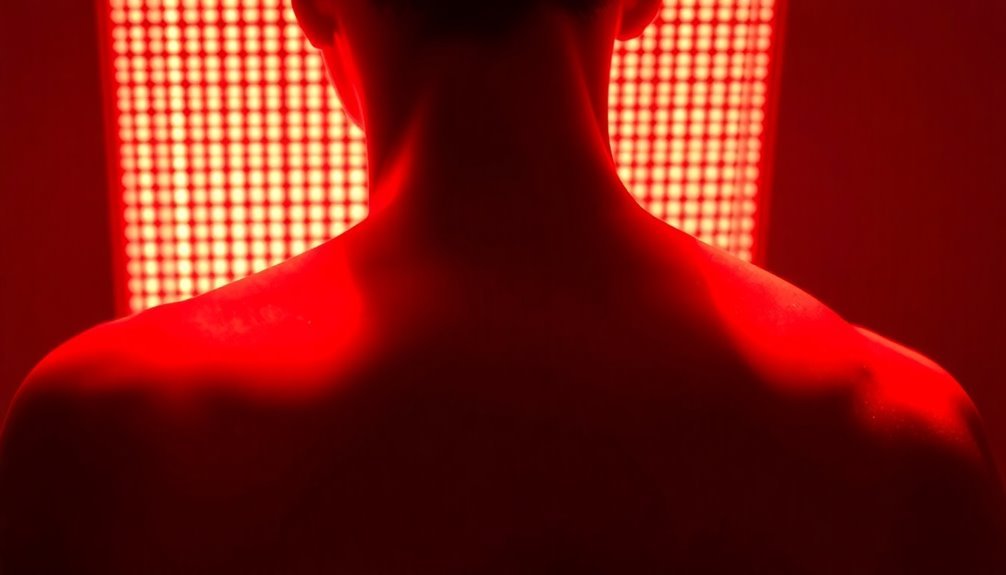
Red light therapy stands as a revolutionary treatment option for those seeking natural pain relief. When you undergo this treatment, you'll benefit from its ability to trigger your body's natural healing processes, particularly in managing shoulder pain and inflammation.
The therapy works by promoting the release of endorphins – your body's natural painkillers – while simultaneously increasing blood flow to affected areas. This noninvasive approach mimics natural sunlight to activate cellular repair mechanisms.
You'll notice that red light therapy doesn't just mask pain; it addresses the root cause by reducing inflammation and supporting tissue repair. If you're dealing with joint stiffness or muscle tension in your shoulders, you'll appreciate how this treatment enhances muscle recovery and stimulates the production of collagen and elastin, which are essential for healthy tissue function.
What makes this therapy particularly effective is its ability to work on multiple levels. While it's relieving your immediate pain, it's also promoting long-term healing by supporting the repair of tendons and cartilage.
You'll experience benefits beyond just pain relief – many patients report improved mobility and reduced swelling in their shoulder area, making it easier to perform daily activities with less discomfort.
The Science Behind Light Treatment
Red light therapy works at the cellular level by penetrating your skin and stimulating mitochondria to produce more ATP, which gives your cells the energy they need to heal and regenerate.
You'll get the best results from wavelengths between 630-850 nanometers, as these penetrate deeply enough to reach damaged shoulder tissues while remaining safe and effective. The therapy is completely non-ionizing radiation, making it safe for regular treatment sessions.
When the light energy reaches your cells, it triggers a cascade of healing responses, including increased collagen production, reduced inflammation, and enhanced blood flow to speed up your recovery.
How Light Affects Cells
Light therapy's effect on cells involves three primary mechanisms that work together to promote healing and reduce pain.
When light enters your cells, it primarily interacts with mitochondria, your cellular powerhouses, by stimulating cytochrome c oxidase. This interaction boosts ATP production, giving your cells more energy to repair and regenerate. Extended exposure to certain wavelengths can cause mitochondrial DNA damage, which is why treatment times should be carefully monitored.
The second mechanism involves the production and regulation of reactive oxygen species (ROS). While excessive ROS can damage cells, controlled amounts actually trigger healing responses. During red light therapy, your cells maintain ideal ROS levels that stimulate repair processes without causing harm. This delicate balance helps reduce inflammation and accelerate healing.
The third mechanism affects your blood vessels and circulation. Red light therapy promotes vasodilation, improving blood flow to injured areas. This enhanced circulation delivers more oxygen and nutrients to damaged tissues while removing waste products more efficiently. Additionally, the light stimulates your cells to release endorphins, your body's natural painkillers, providing relief from shoulder discomfort.
Understanding these cellular mechanisms explains why red light therapy can effectively treat shoulder pain while promoting natural healing processes within your body's tissues.
Healing Through Light Energy
Delving into the science of healing through light energy reveals a fascinating process that transforms specific wavelengths into powerful therapeutic effects.
When red and near-infrared light penetrates your tissues, it triggers a chain of cellular responses that promote natural healing.
Your mitochondria, the powerhouses of your cells, respond to these light wavelengths by increasing ATP production. This boost in cellular energy activates multiple healing mechanisms in your body. Unlike UV rays, red light therapy is completely safe and won't cause any damage to your DNA or skin.
You'll experience improved blood circulation as the light therapy dilates your blood vessels, allowing more oxygen and nutrients to reach damaged tissues in your shoulder.
The light energy doesn't just stop there – it specifically targets inflammation by stimulating enzymes that reduce swelling. You're also getting enhanced tissue repair as the light promotes cellular regeneration and triggers the release of endorphins for natural pain relief.
Research has shown that wavelengths between 670 nm and 830 nm are particularly effective at penetrating deep into shoulder tissues.
What makes this therapy even more remarkable is that it's using non-ionizing radiation, so you won't experience any DNA damage. Instead, you're leveraging your body's natural healing mechanisms, accelerated by precisely targeted light energy.
Wavelengths That Work Best
Understanding wavelength selection is essential for effective shoulder pain treatment. The most effective wavelengths for shoulder pain relief fall within two specific ranges: red light (600-700 nm) and near-infrared light (780-850 nm). These wavelengths penetrate several centimeters beneath your skin's surface, reaching deep into shoulder tissues without causing harm to your cells or DNA. This non-ionizing radiation treatment is completely safe for regular use.
When you're targeting shoulder pain, these specific wavelengths stimulate your cells to produce more ATP, your body's energy currency. They'll trigger the release of endorphins, your natural painkillers, while promoting better blood flow through vasodilation.
You'll benefit from reduced inflammation as the light therapy decreases pro-inflammatory cytokines in your shoulder tissues.
For ideal results, you'll want to use devices that deliver these precise wavelengths consistently. Apply the treatment directly to your shoulder area for 5-15 minutes daily.
While you can find various red light therapy devices on the market, make certain you're choosing one that provides these specific wavelengths. It's worth consulting a healthcare professional to determine the right treatment parameters for your particular shoulder condition.
Treating Shoulder Pain Naturally

You can manage shoulder pain effectively at home using natural treatments that don't rely on medication, including cold compresses for swelling and heat therapy for muscle tension.
Natural anti-inflammatory approaches like red light therapy work alongside traditional remedies to reduce pain and promote healing in the affected area. Physical therapy exercises can help restore flexibility and strength while relieving stiffness in the shoulder joint.
Healing Without Pain Medication
Through natural healing methods, shoulder pain can be effectively managed without relying on medication. You'll find that combining cold and heat therapy creates a powerful healing approach – use ice packs to reduce inflammation and swelling, then switch to heat therapy to increase blood flow and promote healing.
Physical therapy techniques form the cornerstone of medication-free treatment. Studies show that supervised physiotherapy sessions have an 89% adherence rate with significant improvements in pain relief. You can perform strengthening exercises like shoulder rolls and wall push-ups, while incorporating stretches such as the pendulum stretch and cross-body reach.
These exercises will improve your flexibility and build strength in the affected area.
Your lifestyle choices play a vital role in recovery. Make sure you're maintaining good posture throughout the day and adjust your workspace ergonomically to prevent further strain.
When you're experiencing pain, modify your activities and give your shoulder adequate rest. Don't forget about the mind-body connection – practices like mindfulness meditation and deep breathing can help manage discomfort.
For home care, alternate between cold compresses and heat packs as needed. Pay attention to your neck position, as it's often connected to shoulder issues.
Remember to perform your prescribed exercises regularly, but don't push through severe pain.
Natural Anti-inflammatory Treatments
Natural remedies offer powerful anti-inflammatory benefits for shoulder pain management. You'll find relief through herbal applications like lavender oil, turmeric, and ginger, which reduce inflammation while promoting healing. These natural solutions work alongside physical interventions to create a thorough treatment approach. The proper use of synovial fluid lubricants in the joint capsule helps maintain healthy cartilage function.
| Natural Treatment | Benefits |
|---|---|
| Epsom Salt Baths | Relaxes joints, speeds healing |
| Heat Therapy | Soothes stiff muscles, improves circulation |
| Cold Compresses | Reduces swelling, numbs sharp pain |
| Anti-inflammatory Foods | Fights inflammation, supports recovery |
Your dietary choices play a vital role in managing inflammation. Include lime juice for its antioxidant properties and aloe vera, which you can apply topically or consume internally. When you're dealing with acute pain, alternate between ice therapy for fresh injuries and heat therapy for chronic discomfort.
Don't overlook the power of rest and compression. Using elastic medical bandages helps control swelling, while giving your shoulder adequate rest promotes natural healing. For effective results, combine these treatments with gentle exercises once the acute pain subsides. Remember to apply cold compresses up to five times daily for acute inflammation, and use heat therapy to maintain muscle relaxation.
Daily Recovery At Home
Managing shoulder pain at home requires a strategic combination of proven treatment methods.
You'll find significant relief by alternating between cold and heat therapy throughout your recovery process. Apply cold compresses for up to 20 minutes, five times daily, especially right after pain occurs.
Once a few days have passed, switch to heat therapy using a heating pad or hot water bottle to increase blood flow and promote healing.
You can speed up your recovery by incorporating gentle exercises into your daily routine. Start with simple movements like shoulder rolls, arm circles, and pendulum stretches.
As you progress, add strengthening exercises such as external and internal rotations to build muscle stability. Remember to perform these movements carefully to avoid aggravating your condition.
Rest plays a vital role in your recovery, so modify your activities to prevent further strain. Avoid lifting your affected arm overhead and stick to movements that don't increase pain.
While you're healing, continue your prescribed physical therapy exercises at home – they're just as effective as supervised sessions when done correctly.
Combine these methods consistently for the best results in managing your shoulder pain.
Red Light Versus Traditional Medicine
Modern medical breakthroughs have revealed that red light therapy offers significant advantages over traditional medical treatments for shoulder pain. Unlike conventional medications that often come with unwanted side effects and potential dependency risks, red light therapy provides a non-invasive, natural approach to pain management that's both safe and effective.
When you choose red light therapy, you're opting for a treatment that works with your body's natural healing processes. The specific wavelengths penetrate deep into your shoulder tissues, stimulating cellular activity and increasing ATP production.
This boost in cellular energy helps repair damaged tissue while reducing inflammation and swelling. You'll also benefit from the release of endorphins, your body's natural pain relievers.
Traditional treatments like pain medications and injections only mask symptoms, but red light therapy addresses the root cause of your shoulder pain. It's particularly valuable because you can administer it at home, eliminating the need for frequent medical visits.
What's more, you can safely combine it with other treatments to enhance their effectiveness, making it a versatile addition to your recovery plan.
Optimal Treatment Duration and Frequency
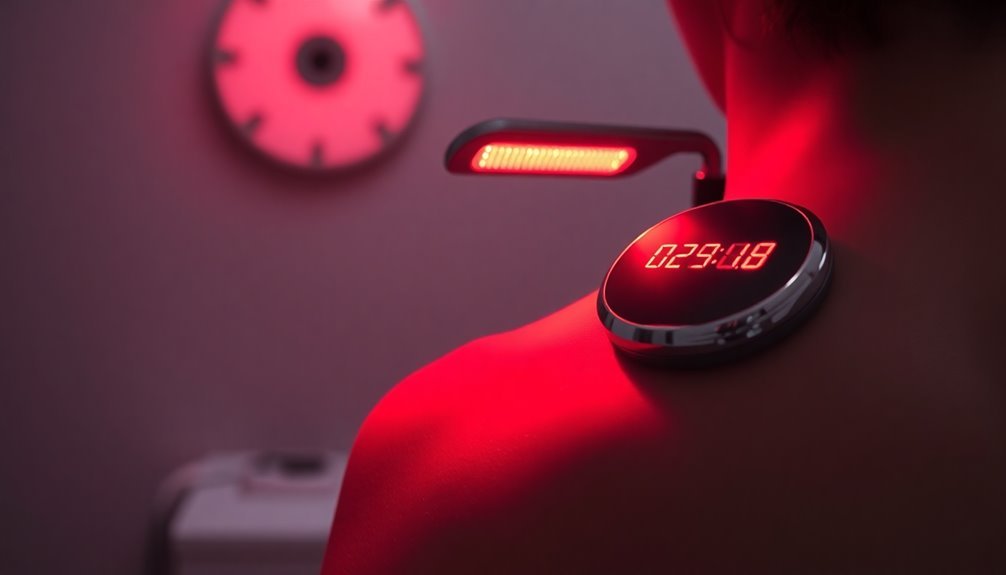
You'll get the best results from red-ray treatment by scheduling 20-minute sessions at consistent times each day.
When planning your daily treatments, you can choose any time that works for your schedule, as the therapy remains equally effective regardless of when it's administered.
While individual needs may vary, maintaining regular daily sessions is more beneficial than trying longer but irregular treatments.
Daily Treatment Timing Recommendations
A successful red-ray treatment plan for shoulder pain relies on consistent timing and proper duration of sessions. You'll want to schedule 20-minute sessions daily, as this standard duration has proven effective for pain relief and improved range of motion.
You can safely use red-ray therapy every day, as it's been shown to be risk-free with virtually no adverse effects. If you're using a home system, try to establish a regular time for your treatments to help maintain consistency.
Make sure you're using a therapy pad that fully covers your shoulder area for ideal results.
Your specific treatment timing might need adjustment based on your condition's severity and response to therapy. You'll get the best results by integrating these sessions into an all-encompassing treatment approach. If you're also receiving physical therapy or chiropractic care, coordinate your red-ray sessions to complement these treatments.
For maximum benefit, stick to your prescribed schedule, even after you begin feeling improvement. While the standard session length is 20 minutes, you should consult with a healthcare professional to determine if you need to modify this duration based on your particular condition.
Ideal Session Frequency Pattern
Effective red-ray therapy for shoulder pain follows a proven frequency pattern that enhances healing results. You'll want to start with 3-5 sessions per week, which research shows provides the most beneficial outcomes for shoulder conditions.
Initially, daily treatments can help jumpstart your healing process, but you'll need to adjust the frequency based on how your shoulder responds.
For the best results, keep your sessions between 10-20 minutes. Position yourself 10-15 cm from the light source to prevent overstimulation while ensuring effective penetration into your shoulder tissues.
If you're dealing with deep tissue issues, you might benefit from sessions closer to the 20-minute mark.
Don't worry if you miss a day – you can make it up, but avoid doing back-to-back sessions regularly. It's better to space your treatments 1-2 days apart once you're past the initial intensive phase.
While red-ray therapy is generally safe, you'll need to monitor your skin's reaction and adjust accordingly. Remember that more isn't always better – excessive use can actually diminish the positive effects you're seeking.
Shoulder Bursitis Relief Methods
Shoulder bursitis sufferers can find relief through a thorough range of treatment options. You'll want to start with the RICE method – rest, ice, compression, and elevation – as your first line of defense against pain and inflammation.
Within the first five days, apply ice packs regularly, then switch to heat therapy once the initial inflammation subsides.
For medication-based relief, you can use topical treatments like pain-relieving creams or gels, along with oral NSAIDs to reduce swelling. If these don't provide enough relief, your doctor might recommend corticosteroid injections or aspiration to drain excess fluid from the bursa. In cases of infection, you'll need antibiotics to prevent the spread.
Physical therapy plays a vital role in recovery. You'll benefit from gentle exercises like door presses and stick lifts to strengthen your shoulder muscles. Your therapist might also use taping and bracing techniques to improve function.
For chronic cases, you'll need to focus on correcting postural issues and strengthening your rotator cuff. Remember to modify your daily activities to prevent symptom flare-ups, and don't hesitate to think about surgery if conservative treatments aren't effective.
Your Home Treatment Guide
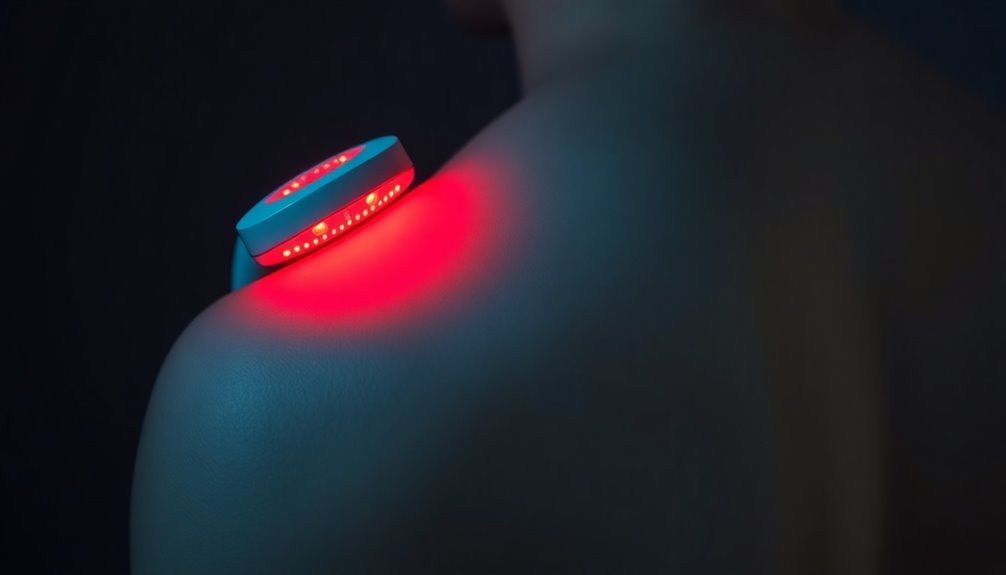
Red light therapy's potential to heal makes it an excellent choice for at-home shoulder treatment. You'll benefit from its pain-relieving properties while stimulating your body's natural healing processes.
The therapy works by delivering photons through your skin, triggering increased cellular activity and ATP production essential for muscle repair.
To get the best results, position the therapy pad to cover your entire shoulder area. You'll want to maintain consistent 20-minute sessions, during which the light penetrates your tissue, releasing endorphins and nitric oxide.
These compounds work together to increase blood flow, reduce inflammation, and deliver more oxygen to the affected area.
You can safely combine this treatment with other therapeutic approaches like physical therapy or massage. The non-invasive nature of red light therapy means you won't experience significant side effects, and you'll often notice improvements in both pain levels and mobility.
As you continue treatment, you'll benefit from enhanced muscle activation and improved neuromuscular coordination. The therapy supports nerve and tissue regeneration while promoting overall cellular repair, making it an effective tool for managing your shoulder pain at home.
Common Shoulder Pain Causes
Many people experience shoulder pain due to various underlying conditions affecting the joint's complex structure.
Your shoulder pain might stem from trapped or inflamed tendons, where rotator cuff tendons become compressed under the bone, leading to inflammation and damage. You'll often find this accompanied by bursitis, where the fluid-filled sacs cushioning your joints become irritated.
Arthritis is another major culprit, with osteoarthritis being the most common type affecting shoulders. If you've got rheumatoid arthritis, you'll notice swelling in the joint lining, while posttraumatic arthritis can develop after injuries like fractures or dislocations.
Bone spurs can also rub against your rotator cuff, causing persistent discomfort.
You might be dealing with fractures or instability issues, including shoulder dislocations or separations. Frozen shoulder can develop when abnormal tissue builds up in your joint, restricting movement.
If you're experiencing recurring pain, it could be from overuse, especially if you perform repetitive overhead motions. Sometimes, your shoulder pain isn't even originating from the joint itself – it might be referred pain from your neck or other nearby areas.
Cellular Healing Through Light
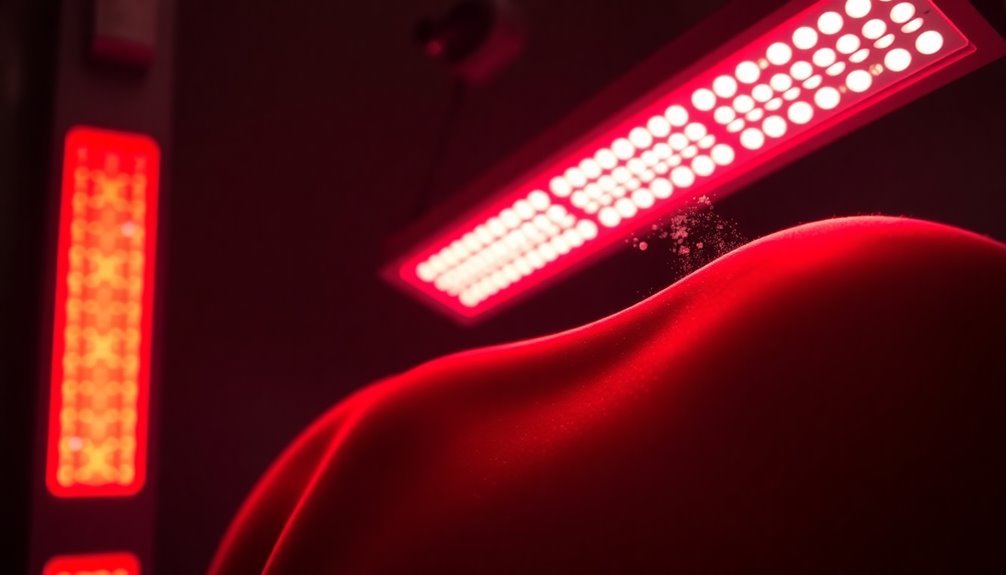
Light therapy revolutionizes cellular healing by targeting the fundamental building blocks of recovery. When you receive red-ray treatment for your shoulder pain, the light penetrates deep into your tissue, triggering a cascade of cellular responses that accelerate healing and reduce discomfort.
At the core of this therapy's effectiveness is its ability to supercharge your mitochondria – the powerhouses of your cells. The light energizes your cells' cytochrome b structure, boosting ATP production and enhancing cellular energy levels.
This increased energy allows your cells to repair damaged tissue more efficiently while simultaneously reducing inflammation in your shoulder.
You'll benefit from improved circulation as the therapy stimulates the formation of new blood vessels and promotes vasodilation. This enhanced blood flow delivers more oxygen and nutrients to your injured shoulder tissue while helping remove inflammatory waste products through increased lymphatic activity.
The therapy also triggers your body's natural anti-inflammatory response, reducing swelling and pain.
The cellular regeneration process is accelerated as light therapy reverses cell death and prevents excessive scar tissue formation, helping your shoulder's soft tissues – including tendons, ligaments, and bursae – heal more effectively.
Combining Therapies for Best Results
To maximize your shoulder pain recovery, combining red-ray treatment with other therapeutic approaches creates a powerful synergy of healing effects.
When you pair red-ray therapy with exercise, you'll experience enhanced pain reduction and markedly better shoulder function compared to exercise alone. The therapy accelerates your body's natural healing processes while reducing inflammation, making it an ideal complement to physical activity.
You'll find particularly strong benefits when combining red-ray treatment with manual therapy techniques. This combination improves blood circulation and promotes tissue repair, while mobilization techniques target the cervicothoracic and thoracic spine for thorough relief. The synergistic effects can match the short-term benefits of injections for certain shoulder conditions.
You can also integrate red-ray therapy with other treatment modalities like low-level laser therapy or physical therapy exercises. It's a risk-free alternative to pharmaceuticals that you can conveniently administer at home.
While research continues to explore the full potential of combination therapies, current evidence suggests that this multi-modal approach offers superior outcomes for shoulder pain management compared to single-treatment strategies.
Light Treatment Safety Guidelines
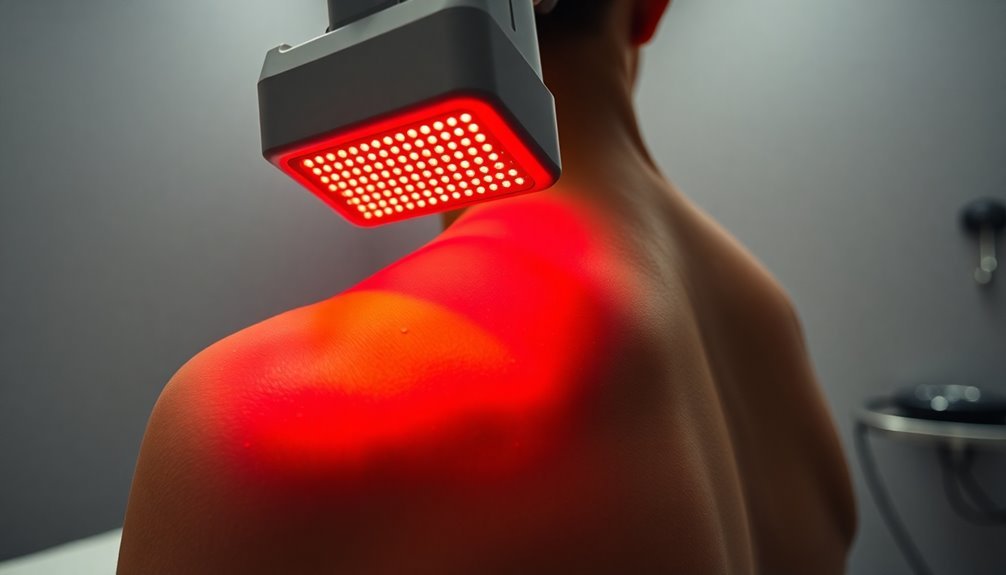
Ensuring safe use of red-ray therapy starts with understanding essential precautions. Always follow your device's specific instructions and wear protective goggles to shield your eyes from potential damage.
If you have sensitive skin or conditions like lupus, consult your healthcare provider before starting treatment.
To prepare for each session, clean your skin thoroughly and remove any makeup or jewelry that might interfere with the treatment. You'll want to position yourself comfortably as directed by your device's manual.
After treatment, avoid immediate sun exposure and apply extra sunscreen to protect your skin.
Don't ignore warning signs during treatment. If you experience more than mild discomfort or notice skin redness and blistering, stop using the device immediately.
You'll need to be especially cautious if you're taking medications that increase light sensitivity or if you have a history of skin cancer.
Choose only FDA-cleared devices for your shoulder pain treatment, but remember that clearance indicates safety, not guaranteed effectiveness.
If you have darker skin, you'll need to consult a dermatologist first, as your skin may be more sensitive to light therapy.
Frequently Asked Questions
Can Red Light Therapy Help With Frozen Shoulder Syndrome?
Yes, you'll find red light therapy can help your frozen shoulder by reducing pain, improving circulation, and increasing range of motion. It's a non-invasive treatment that stimulates natural healing through photobiomodulation.
What Temperature Does the Skin Feel During Red Light Treatment?
During red light therapy, you'll feel a mild warmth on your skin, but it shouldn't exceed 41°C (106°F). If it feels uncomfortably hot, you should increase the distance from the device or reduce treatment time.
Should I Wear Protective Eyewear During Shoulder Red Light Therapy?
Yes, you must wear protective eyewear during any red light therapy session, even for shoulder treatment. It is crucial to protect your eyes from potential damage, as direct exposure to red light can be harmful.
Can I Use Red Light Therapy Immediately After Shoulder Surgery?
You shouldn't use red light therapy immediately after shoulder surgery. Wait until your wound has completely healed and stitches are removed. Always get your surgeon's approval first before starting any treatment.
Does Skin Color or Thickness Affect Red Light Therapy Effectiveness?
Your skin color or thickness won't substantially affect red light therapy's effectiveness. Red light can penetrate 5-10mm deep, making it effective across all skin types while maintaining consistent results for everyone.
In Summary
You'll find red light therapy to be a promising natural treatment for shoulder pain and inflammation. Whether you're dealing with an acute injury or chronic condition, this non-invasive approach can speed up your healing process. Combine it with other therapies like gentle stretching and proper rest for best results. Remember to follow safety guidelines and consult your healthcare provider before starting any new treatment regimen.

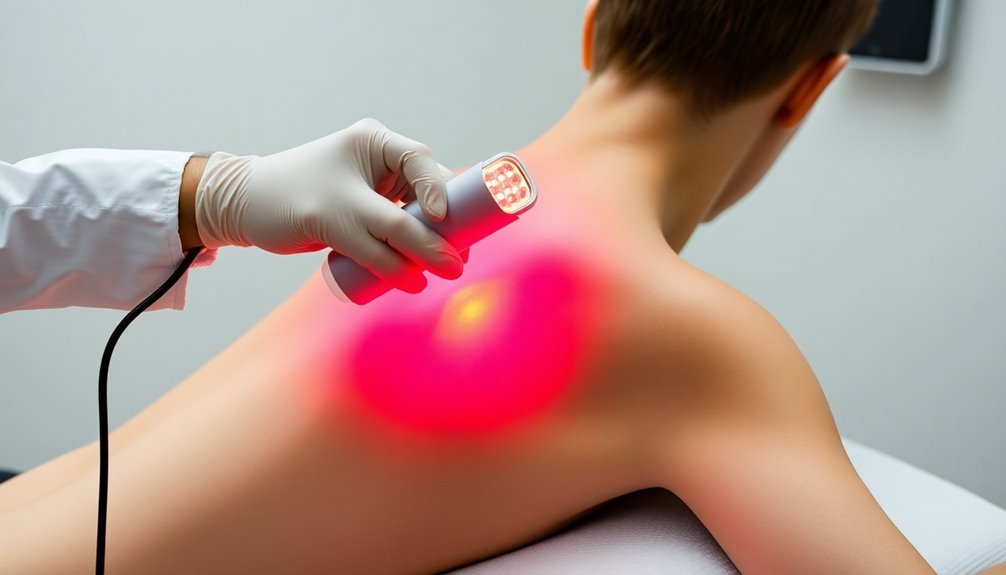



Leave a Reply